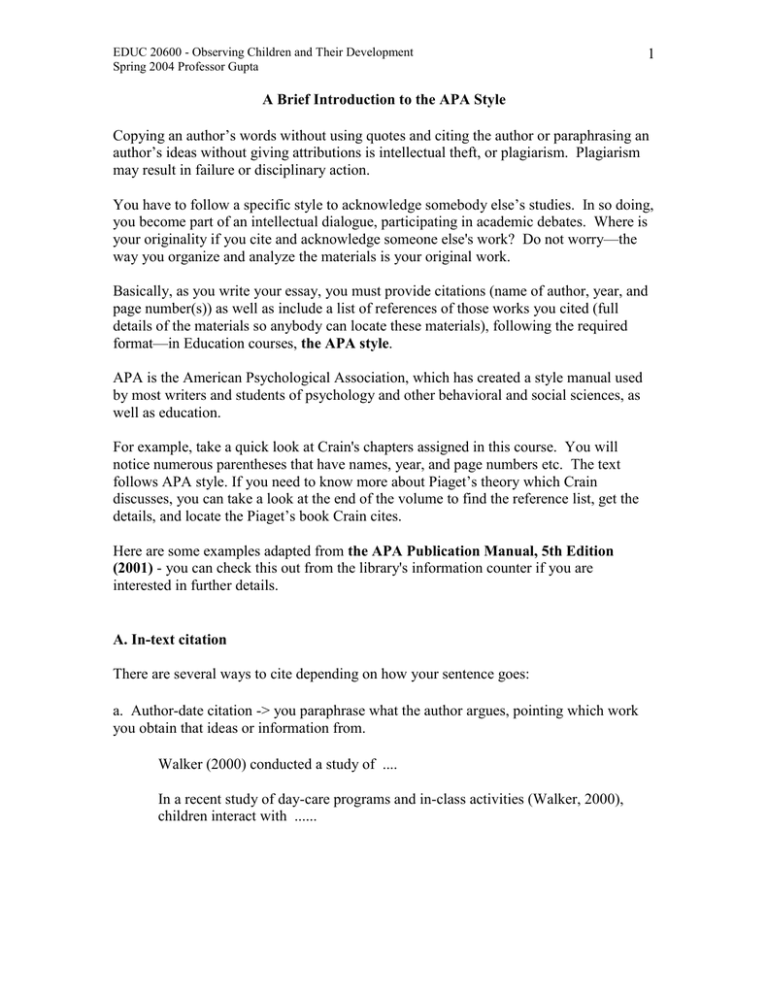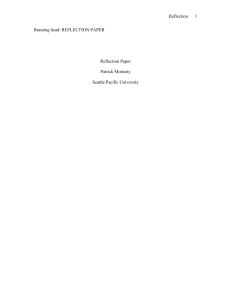1 Copying an author’s words without using quotes and citing the author... author’s ideas without giving attributions is intellectual theft, or plagiarism. ... A Brief Introduction to the
advertisement

EDUC 20600 - Observing Children and Their Development Spring 2004 Professor Gupta 1 A Brief Introduction to the APA Style Copying an author’s words without using quotes and citing the author or paraphrasing an author’s ideas without giving attributions is intellectual theft, or plagiarism. Plagiarism may result in failure or disciplinary action. You have to follow a specific style to acknowledge somebody else’s studies. In so doing, you become part of an intellectual dialogue, participating in academic debates. Where is your originality if you cite and acknowledge someone else's work? Do not worry—the way you organize and analyze the materials is your original work. Basically, as you write your essay, you must provide citations (name of author, year, and page number(s)) as well as include a list of references of those works you cited (full details of the materials so anybody can locate these materials), following the required format—in Education courses, the APA style. APA is the American Psychological Association, which has created a style manual used by most writers and students of psychology and other behavioral and social sciences, as well as education. For example, take a quick look at Crain's chapters assigned in this course. You will notice numerous parentheses that have names, year, and page numbers etc. The text follows APA style. If you need to know more about Piaget’s theory which Crain discusses, you can take a look at the end of the volume to find the reference list, get the details, and locate the Piaget’s book Crain cites. Here are some examples adapted from the APA Publication Manual, 5th Edition (2001) - you can check this out from the library's information counter if you are interested in further details. A. In-text citation There are several ways to cite depending on how your sentence goes: a. Author-date citation -> you paraphrase what the author argues, pointing which work you obtain that ideas or information from. Walker (2000) conducted a study of .... In a recent study of day-care programs and in-class activities (Walker, 2000), children interact with ...... EDUC 20600 - Observing Children and Their Development Spring 2004 Professor Gupta 2 In a recent study of day-care settings, Walker (2000) described..... Walker also found that ... [Note: Within a paragraph, you need not include the year in subsequent references to a study as long as the study cannot be confused with other studies cited in the article.] b. To cite specific parts of a source, indicate the page, chapter, or equation at the appropriate point in the text. Always give page numbers for quotations. According to Cheek and Buss (1981, p.332), ....... ...... (Cheek & Buss, 1981, p.332). Cheek and Buss (1981) found that “...[exact quote]” (p.332). ........ (Shimamura, 1989, Chap.3). Shimamura (1989, Chap.3) pointed out ..... It was found that “.......” (Miele, 1993, p.276). Miele (1993) concluded that “.........” (p.276), although she did not clarify which behaviors were examined. [Here, the latter half of the above sentence is an evaluation comment on Miele's study, not what Miele said, so put the citation prior to any evaluation on your end.] * In your response essay, try to explain what the author discusses in your own words, avoiding direct quotes as much as possible. This process will help you lean the material a lot. Just copying the text (without thinking about the content) may keep you awake, but your mind will sleep! c. Citation of a work discussed in a secondary source. Lopez and Johnson's study (as cited in Brown, 1993) is another example of ….. [In the reference list, list only Brown’s article. You do not need to include Lopez and Johnson’s article there, if you did not read it and what you read in Brown’s article is sufficient in your argument).] Piaget (1969, pp. 151-53, 160, as cited in Crain 1992, p. 124) considered it was inappropriate for teachers to explain one-sidedly what children need to know. [Note p.___ for just one page and pp.___ - ___ for multiple pages.] [The reference list includes Crain's volume, not Piaget's book, unless you read the original text written by Piaget.] [This example is adapted from Crain's earlier edition and does not correspond with the copy you have.] EDUC 20600 - Observing Children and Their Development Spring 2004 Professor Gupta 3 B. Format for a reference list at the end of your essay List under the heading called References. In general, articles or books appear in the following format- sorted by Author's name alphabetically. (for a book) Author's last name, Initials. (year). Title of the book (edition, if any). Publisher's location, State: Name of the publisher. e.g. Crain, W. (2001). Theories of development: Concepts and applications (4th ed.). Upper Saddle River, NJ: Prentice Hall. (for an article) Author's last name, Initials. (year). Title of the article. Name of Journal, Volume No, page numbers. e.g. Zimmerman, B. J., and Rosenthal, T. L. (1974). Conserving and retaining equalities and inequalities through observation and correction. Developmental Psychology, 10, 260268. [note page numbers of a journal article is not listed as "p.__" or "pp.___-___") (for an article or a chapter in an edited volume) Author's last name, Initials. (year). Title of the article. In Initials Last names of editors, (Eds.), Title of the book: Subtitle of the book (pp. __-__). Publisher's location, State: Name of Publisher. e.g. Massero, D. (1992). Broadening the domain of the fussy logical model of perception. In H. L. Pick, Jr., P. van den Broek, & D.C. Knill (Eds.), Cognition: Conceptual and methodological issues (pp. 51-84). Washington, DC: American Psychological Association. [cite as (Massero, 1992) in text.] EDUC 20600 - Observing Children and Their Development Spring 2004 Professor Gupta 4 Using the examples used in Section B, the reference list looks like... References Crain, W. (2001). Theories of development: Concepts and applications (4th ed.). Upper Saddle River, NJ: Prentice Hall. Massero, D. (1992). Broadening the domain of the fussy logical model of perception. In H. L. Pick, Jr., P. van den Broek, & D.C. Knill (Eds.), Cognition: Conceptual and methodological issues (pp. 51-84). Washington, DC: American Psychological Association. Zimmerman, B. J., and Rosenthal, T. L. (1974). Conserving and retaining equalities and inequalities through observation and correction. Developmental Psychology, 10, 260268. Optional Practice Use CUNY+ in the library. 1. Locate a book written by Jeffery Trawick-Smith. You are only given the partial title of the book, "Early Childhood Development." Find the year of publication, the full title of the book, edition, the publisher, and its location. 2. Locate a book written by Carol Gilligan, which was published in 1982. Find the complete title of the book, the publisher, and its location 3. Complete a reference list of these two books, following the APA style. Answer Key References Gilligan, C. (1982). In a different voice: Psychological theory and women's development. Cambridge, MA: Harvard University Press. Trawick-Smith, W. (2003). Early childhood education: A multi-cultural perspective (3rd ed.). Upper Saddle River, NJ: Merrill.



